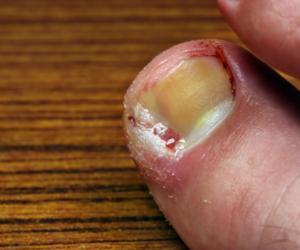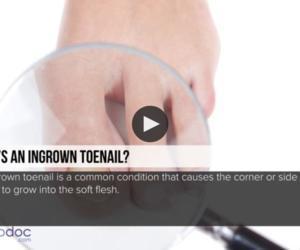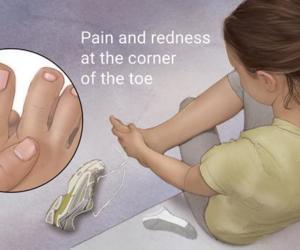“I have an ingrown toenail. How would it be removed?”
I need an ingrown toenail removed because it's becoming quite bothersome. How will this be done?
17 Answers
Podiatrist(FootandAnkleSpecialist)IngrownToenail
First, the toe is usually numbed. Then all or part of the nail is removed. That part of the nail root is either removed or treated with a chemical so it will never grow back. This is generally done in an office.
Kathleen Neuhoff, DPM
Kathleen Neuhoff, DPM
Your doctor will numb your toe so the ingrown toenail can be removed. At that point, the offending nail border will be removed and a bandage will be placed on your tone. You will be given soaking instructions for the following week to care for the toe after the procedure
Most likely it will have to be done under local anesthesia. The part of the nail that is growing into the skin will have to be surgically excised.
Go visit Podiatrist near your house. He will examine your ingrown nail. After examining the toe, Podiatrist will select the treatment best suited for you. If an infection is present, an oral antibiotic may be prescribed.
Sometimes a minor surgical procedure, often performed in the office, will ease the pain and remove the offending nail. After applying a local anesthetic, the podiatrist removes part of the ingrown nail’s side border. Some nails may become ingrown again, requiring removal of the nail root.
Podiatrist will perform ingrown nail removal procedure, a light bandage will be applied. Most people experience very little pain after surgery and may resume normal activity the next day. If your surgeon has prescribed an oral antibiotic, be sure to take all the medication, even if your symptoms have improved.
Sometimes a minor surgical procedure, often performed in the office, will ease the pain and remove the offending nail. After applying a local anesthetic, the podiatrist removes part of the ingrown nail’s side border. Some nails may become ingrown again, requiring removal of the nail root.
Podiatrist will perform ingrown nail removal procedure, a light bandage will be applied. Most people experience very little pain after surgery and may resume normal activity the next day. If your surgeon has prescribed an oral antibiotic, be sure to take all the medication, even if your symptoms have improved.
Ingrown toenails can be effectively managed during an ambulatory visit at a specialist clinic. A common procedure performed is the removal of the affected nail margin with chemical cauterization of the nail matrix utilizing phenol (an acid solution). This is done under a digital local anesthetic block. The acid solution destroys the cells of the matrix responsible for regenerating the nail in this region preventing recurrence. Recovery from this procedure is usually very quick with recommendations of warm water soaks frequently with Epsom salts and maintenance of local bandage for 10 to 14 days. In the event the ingrown nail has associated infection which prevents the use of phenol, the offending nail spicule may be removed under a digital anesthetic block and you may be given a short course of oral antibiotic to assist in resolving the infection. In this latter circumstance, the nail will likely regenerate and there may be the future risk of recurrence.
Hello,
If you have an ingrown nail it can be temporarily removed under local anesthesia in the office. It is a 10 minute procedure where we numb your toe up with a needle and some Lidocaine. The ingrown nail is freed from the surrounding skin, cut and removed. Healing time is about 5 days with a dry band aid daily.
Dr. Lui
If you have an ingrown nail it can be temporarily removed under local anesthesia in the office. It is a 10 minute procedure where we numb your toe up with a needle and some Lidocaine. The ingrown nail is freed from the surrounding skin, cut and removed. Healing time is about 5 days with a dry band aid daily.
Dr. Lui
Generally physician will anesthetize the toe. Once it is anesthetized, a portion of the nail be removed and generally a chemical is put on the nail root to try to prevent it from reoccurring.
Jonathan M. Kletz, DPM
Jonathan M. Kletz, DPM
Usually we use a local anesthetic to make the area numb, then with specialized tools, we remove the offending border of the nail. I prefer to use a minimal approach to not damage the aesthetics of the nail.
Ahmad Farah, DPM
Ahmad Farah, DPM
There are two ways to remove an ingrown nail. If it is infected, then after local anesthetic is performed at the base of the toe, the offending nail margin is removed. A small dressing is applied that day and the next day you’re in a Band-Aid. If this is a recurrent ingrown nail and it is not infected, a local anesthetic it is again, performed with the base of the nail, the offending nail margin is removed, and phenol chemical is applied to the base of the nail to eradicate the root of the nail and thus prevent an ingrown nail from ever recurring in that area. Again, a small dressing is applied and the patient is in a Band-Aid the next day.
The type of procedure depends on the severity of the ingrown toenail. Some ingrown toenails can be easily clipped out and some need a more invasive procedure. You should see a Podiatrist to have your toe examined.
Your podiatrist will numb your toe and remove the offending border. In your situation this will likely be done in a permanent fashion.
Your podiatrist will numb your toe and remove the ingrown portion of the nail, put medication in the grove to stop it from coming back.
There are various methods. One is to remove the entire nail, or only removing the corner, or removing the corner and cauterizing the root, after anesthetizing the toe of course. Speak with your doc about which option may be best for you.
The toe is numbed and then the nail portion is removed and an acid (or not) is placed and then covered.
The usual procedure done by a podiatrist will involve local anesthesia to the affected toe, removal of the offending border(s), and application of an acid to stop the borders from growing again. This is a permanent procedure and is relatively painless with an easy recovery.
There are 2 types of removals: A nail Avulsion, where the nail is removed from the tip of the toe back to the 'root.' This is done under local anesthesia. The second type is called a Matricectomy, and the same procedure as above is performed, but then a chemical is applied to the most proximal part of the nail fold where the nail grows from to burn the growth cells of the offending border, and the goal of this procedure is to be a 'permanent' removal. So the edge bothering you should not grow back. You can look up these procedures on line, or even watch a video on YouTube of the procedures.














